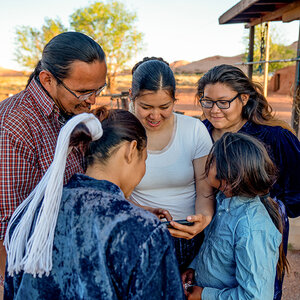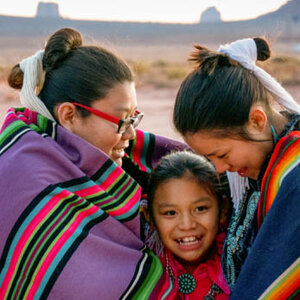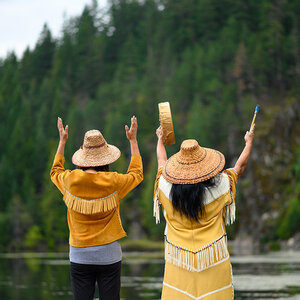2022 review: Indigenous organizations, issues saw greater visibility

Indigenous organizations and causes have been underrepresented in U.S. philanthropy historically, and while they’re still not getting the attention—or the funding—their leaders want to make the impacts being called for, grants and initiatives focused on Native/Indigenous groups made more headlines in 2022.
During this year’s United Nations Climate Change Conference (COP27), large commitments were announced to help Indigenous communities around the world safeguard forests and fund Indigenous practices for agriculture, and other significant commitments were being paved in the United States and Canada, especially in support of groups working in the areas of community development and education.
In October, for example, influential foundations such as the Mastercard Foundation committed millions to Indigenous youth through its EleV Program with the goal of providing 100,000 Indigenous youth across Canada with higher education and career opportunities. Indigenous-focused organizations such as the Decolonizing Wealth Project and Liberated Capital used the giving momentum they saw during the height of the COVID-19 pandemic to keep funders’ attention for long-term needs, fueling their visibility and impact in 2022.
“Historically, less than 1 percent of philanthropic grants and funding go to Indigenous organizations,” said founder and principal of the Decolonizing Wealth Project and Liberated Capital Edgar Villanueva. “Native American leaders have been organizing to disrupt the system and build power and visibility across nearly every sector, from philanthropy to entertainment and politics. We witnessed the power of Indigenous organizing during COVID, when we came together to bring visibility to the communities facing the highest infection rates. Thanks to the infrastructure that has been built through these efforts, Native-led philanthropic intermediaries were able to respond quickly to move resources and take care of our communities.”
During the height of the pandemic, Liberated Capital created a Native American Community Response fund that awarded more than $1 million to nearly 100 U.S.-based organizations. The rapid response grants impacted 503,625 Native individuals, according to the organization. “This quick action cemented our place in the ecosystem as core partners to help large foundations advance their racial equity goals,” said Villanueva.
This summer, the organization joined forces with the Christensen Fund and the California Endowment to establish a fund specific to Indigenous Californians. In partnership, the three organizations committed a total of $500,000 with a goal of raising $5 million to preserve tribal history in the state.
“The work that we and other like-minded Indigenous-led organizations have done to increase visibility in the philanthropic sector and beyond has also prompted a shift in focus to Indigenous peoples and organizations,” said Villanueva. “We made noise to call attention to the disproportionate funding that Indigenous organizations receive, and the funders took note.”
The work that we and other like-minded Indigenous-led organizations have done to increase visibility in the philanthropic sector and beyond has also prompted a shift in focus to Indigenous peoples and organization... We made noise to call attention to the disproportionate funding that Indigenous organizations receive, and the funders took note.
This year, funding for initiatives to address Indigenous agriculture and climate change issues included more active leadership from Indigenous-led groups, rather than just large foundations. The Native American Agriculture Fund (NAAF), for instance, became the largest philanthropic organization devoted solely to serving Native farmers and ranchers. In October, it announced commitments of more than $100 million over 12 years to advance sustainable food economies, food access, good nutrition, and health among Native American and Indigenous communities.
“We are optimistic about the increased outreach to tribal communities from philanthropic organizations and encourage continued engagement focused on the sovereign leadership of our tribal nations and Native-led agriculture and land stewardship,” said NAAF chief executive Toni Stanger-McLaughlin.
As with community development, funders and organizers in the Native agriculture space have noticed the shift. Stanger-McLaughlin argued that a focus on Native agriculture is not only beneficial to those within Native spaces but also to the country’s economy as a whole.
“What we see in our work with tribes, nonprofits, educational institutions, and community development financial institutions is that economic growth follows an increase in access to capital for Native producers and conservationists. Indian Country is the ‘rural of rural,’ often in the most remote locations. When we invest in agricultural infrastructure, we drive success for Native producers, which addresses disparities in food access and builds health equity for tribal communities,” Stanger-McLaughlin said. “Tribes are expanding agricultural impacts by leading work such as developing their departments of agriculture, building meat processing facilities, and investing in the next generation of agriculture leaders and land stewards. That impact is increasing visibility, because investing in Indian Country is an investment in rural America’s economic growth so that the surrounding rural population can thrive as well.”
Indeed, Indigenous organizations have worked tirelessly this year to sustain visibility of their issues after the height of the COVID-19 pandemic, and now they’re making a thoughtful argument that funders should stay engaged and reap the positive ripple effects.
(Photo credit: Getty Images/grandriver)
Samantha Mercado is a staff writer at Philanthropy News Digest.







